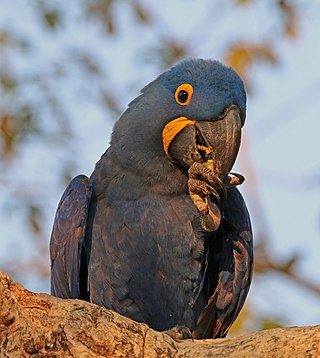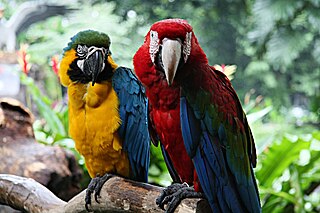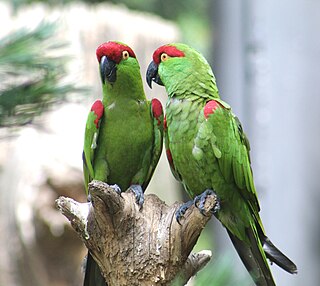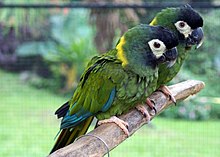
Macaws are a group of New World parrots that are long-tailed and often colorful, in the tribe Arini. They are popular in aviculture or as companion parrots, although there are conservation concerns about several species in the wild.

Conures are a diverse, loosely defined group of small to medium-sized parrots. They belong to several genera within a long-tailed group of the New World parrot subfamily Arinae. The term "conure" is used primarily in bird keeping, though it has appeared in some scientific journals. The American Ornithologists' Union uses the generic term parakeet for all species elsewhere called conure, though Joseph Forshaw, a prominent Australian ornithologist, uses conure.

The green-cheeked parakeet, known as the green-cheeked conure in aviculture, is a species of bird in subfamily Arinae of the family Psittacidae, the African and New World parrots. It is found in Argentina, Bolivia, Brazil, and Paraguay.

The scarlet macaw is a large yellow, red and blue Neotropical parrot native to humid evergreen forests of the Americas. Its range extends from southeastern Mexico to Peru, Ecuador, Colombia, Bolivia, Venezuela and Brazil in lowlands of 500 m (1,600 ft) up to 1,000 m (3,300 ft), the Caribbean island of Trinidad, as well as the Pacific island of Coiba. Formerly, the northern extent of its range included southern Tamaulipas. In some areas, it has suffered local extinction because of habitat destruction, or capture for the parrot trade, but in other areas, it remains fairly common. It is the national bird of Honduras. Like its relative the blue-and-yellow macaw, the scarlet macaw is a popular bird in aviculture as a result of its striking plumage.

The red-and-green macaw, also known as the green-winged macaw, is a large, mostly-red macaw of the genus Ara.

The blue-and-yellow macaw, also known as the blue-and-gold macaw, is a large Neotropical parrot with a mostly blue dorsum, light yellow/orange venter, and gradient hues of green on top of its head. It is a member of the large group of neotropical parrots known as macaws. It inhabits forest, woodland and savannah of tropical Central and South America, as well as the island of Trinidad in the Caribbean. They are popular in aviculture because of their striking color, ability to talk, ready availability in the marketplace, and close bonding to humans.

The hyacinth macaw, or hyacinthine macaw, is a parrot native to central and eastern South America. With a length of about one meter it is longer than any other species of parrot. It is the largest macaw and the largest flying parrot species; the flightless kākāpō of New Zealand outweighs it at up to 3.5 kg. While generally easily recognized, it could be confused with the smaller Lear's macaw. Habitat loss and the trapping of wild birds for the pet trade have taken a heavy toll on their population in the wild, so the species is classified as Vulnerable on the International Union for Conservation of Nature's Red List, and it is protected by its listing on Appendix I of the Convention on International Trade in Endangered Species of Wild Fauna and Flora (CITES).

The blue-throated macaw, also known as the Caninde macaw or Wagler's macaw, is a macaw endemic to a small area of north-central Bolivia, known as Los Llanos de Moxos. In 2014 this species was designated by law as a natural patrimony of Bolivia. Until 2010, it was hunted by native people to make feathered "Moxeño" headdresses for "machetero" ritual dances.

The red-shouldered macaw (Diopsittaca nobilis) is a small green South American parrot, a member of a large group of Neotropical parrots called macaws. The species is named for the red coverts on its wings. It is the smallest macaw, being 30–35 cm (12–14 in) in length - similar in size to the Aratinga parakeets. It is native to the tropical lowlands, savannah, and swamplands of Brazil, the Guianas, Bolivia, Venezuela, and far south-eastern Peru. There are three subspecies: The noble macaw(Diopsittaca nobilis cumanensis), Hahn's macaw(Diopsittaca nobilis nobilis), and the long-winged macaw(Diopsittaca nobilis longipennis). The long-winged macaw is a poorly distinct third subspecies that has longer wings, but is otherwise similar to the noble macaw. The Hahn's subspecies is named for German zoologist Carl-Wilhelm Hahn, who in 1834 began compiling Ornithologischer Atlas oder naturgetreue Abbildung und Beschreibung der aussereuropäischen Vögel (Engl: Ornithological Atlas or natural depiction and description of birds from outside Europe).

Fischer's lovebird is a small parrot species of the genus Agapornis. They were originally discovered in the late 19th century. They are named after German explorer Gustav Fischer.

Ara is a Neotropical genus of macaws with eight extant species and at least two extinct species. The genus name was coined by French naturalist Bernard Germain de Lacépède in 1799. It gives its name to and is part of the Arini, or tribe of Neotropical parrots. The genus name Ara is derived from the Tupi word ará, an onomatopoeia of the sound a macaw makes.

The yellow-faced parrot, formerly also known as the yellow-faced amazon, is the only species of the genus Alipiopsitta. It is a Neotropical parrot, and was classified in the genus Amazona for many years. It is a predominantly green and yellow-plumaged bird with a yellow head. It is a semi-nomadic species found in the cerrado region of Brazil and adjacent Bolivia. As the yellow-faced parrot has disappeared from parts of its former range due to habitat destruction and generally occurs in low densities, it was considered vulnerable by the IUCN, but it remains locally fairly common, occurs in several protected areas and can survive in fragmented habitats, leading to its downlisting to near-threatened.

The thick-billed parrot is a medium-sized parrot endemic to Mexico that formerly ranged into the southwestern United States. Its position in parrot phylogeny is the subject of ongoing discussion; it is sometimes referred to as thick-billed macaw or thick-billed conure. In Mexico, it is locally called guacamaya ("macaw") or cotorra serrana. Classified internationally as Endangered through IUCN, the thick-billed parrot's decline has been central to multiple controversies over wildlife management. In 2018, the estimated wild population in Mexico was 1,700.

The blue-winged macaw, in aviculture more commonly known as Illiger's macaw, is a species of small macaw found in central and eastern South America. The second name is in honor of the German ornithologist Johann Karl Wilhelm Illiger. It was previously placed in the genera Ara or Propyrrhura. Blue-winged macaws have been known to reach an age of 50–60 years.

The blue-headed macaw or Coulon's macaw is a macaw native to eastern Peru, northwestern Bolivia, and far western Brazil. It has a total length of about 41 cm (16 in), making it a member of the group of smaller macaws sometimes known as the mini-macaws, which includes any species of macaw with a total length of 50 cm (20 in) or less. As in all macaws, its tail is long and pointed and the bill is large and heavy.

The yellow-crowned amazon or yellow-crowned parrot is a species of parrot native to tropical South America, Panama and Trinidad and Tobago in the Caribbean. The taxonomy is highly complex and the yellow-headed and yellow-naped amazon are sometimes considered subspecies of the yellow-crowned amazon. Except in the taxonomic section, the following deals only with the nominate group .They are found in the Amazon basin.

The blaze-winged parakeet, known as the blaze-winged conure in aviculture, is a species of bird in subfamily Arinae of the family Psittacidae, the African and New World parrots. It is found in Brazil, Bolivia, Paraguay, and possibly Argentina.

Primolius is a genus of macaws comprising three species, which are native to South America. They are mainly green parrots with complex colouring including blues, reds and yellows. They have long tails, a large curved beak, and bare facial skin typical of macaws in general. They are less than 50 cm long, much smaller than the macaws of the Ara genus. Macaws less than about 50 cm long, including the genus Primolius, are sometimes called "mini-macaws".

Mini-macaws are a loosely defined group of small-to-medium-sized macaw species within the tribe Arini. The term has no fixed taxonomic meaning and is principally used in aviculture to describe a small macaw belonging to one of a number of different genera, with overall length being the sole criterion for inclusion. Any macaw with an overall length of less than about 50 cm can be described as a "mini-macaw". Additionally, the "mini-" prefix may be added to the species name when describing the bird in question. Mini-macaws have predominantly green plumage with various accenting colours.





















